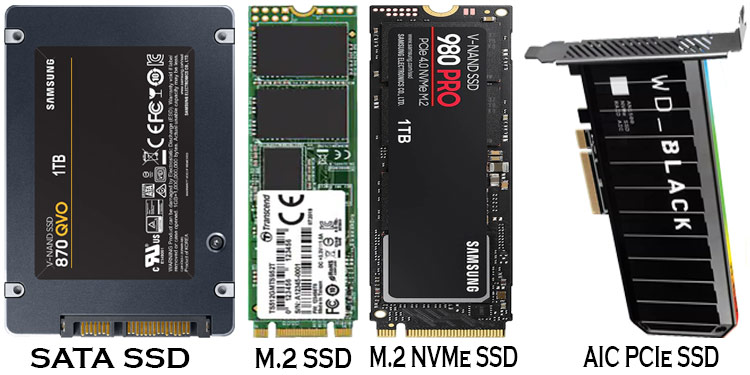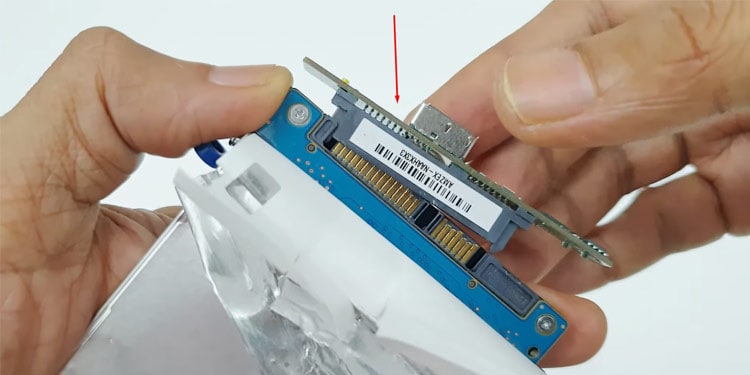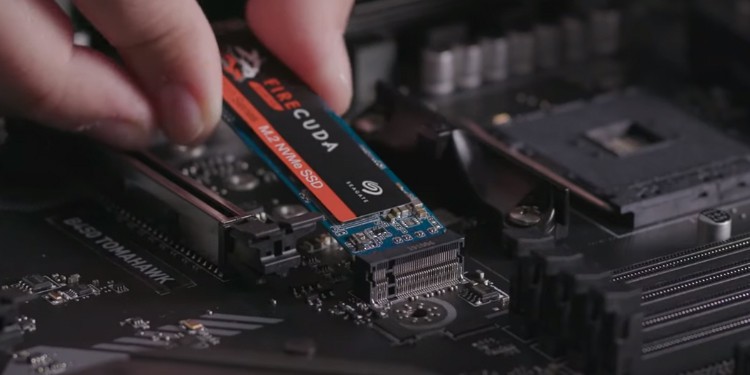In the article below, we briefly look into HDD, SDD, and the form factors they use. Thereafter, we outline the method of installing the drive of your choosing into your laptop.
When to Upgrade Laptop’s Storage
Types of Storage Spaces, Interfaces, and Form Factors
When it comes to upgrading your laptop’s storage, the choice comes down to the type of drive that you want to upgrade to, its form factor, and the interface that is used to connect it to the motherboard. If you don’t know what those are, we have presented a concise description below.
Types of Storage Devices
Modern storage devices are either electro-mechanically driven hard drives, or solid state drives.
Mechanical Hard Drive
Mechanical drives store and retrieve data using magnetic storage. They have rotating platters on a spindle and use a magnetic head on a moving actuator arm to access the physical location of the data, identified as track and sector. Because accessing data requires a mechanical action, they have a relatively high seek latency (typically 2 ms – 12 ms). Data transfer rates are also limited by the speed at which the spindle spins. Most hard drives usually come in 5400 rpm or 7200 rpm speeds, although 10000 rpm and 12000 rpm hard drives also exist. Higher the spin speed, the greater the data transfer rate.
Solid State Drive
Solid State Drives (SSD) use NAND flash modules to store and access data. Because the data is handled using an integrated circuit, SSDs have much lower latency for read, write, and delete operations (typically <0.1 ms). They also do not suffer from mechanical wear and tear. Manufacturers and users alike prefer an SSD over a mechanical drive for their primary drive these days. However, large size SSDs, especially ones over 1 TB in size, can still be cost-prohibitive for most users even today. We recommend that you carefully consider the pros and cons of HDD vs SSD and make a suitable decision for your laptop’s storage upgrade.
Storage Device Interfaces and Form Factor
The method of connecting a storage device to the motherboard is called its interface. Interfaces differ not only in physical form and shape, but also in their bandwidth capacity. Interfaces also dictate the form factor of the storage device being attached.
SATA III
Most modern drives use the Serial ATA (SATA) interface to connect to the motherboard. This includes all mechanical hard drives and also some SSD drives. The SATA interface uses a 15 pin power connector and a 7 pin data connector. You will connect a 2.5” form factor drive using the SATA interface. The latest revision to SATA standard is SATA III, which supports a maximum data transfer rate of 600 MB/s.
M.2
M.2 interface is employed for internally mounted storage devices. Technically speaking, the M.2 standard is a mounting specification that can utilize either the PCIe, SATA or USB interfaces. Most modern M.2 devices conform to NVMe specifications, which utilize PCIe bus for data transfer. M.2 devices are rectangular, look like a RAM stick, and connect to the M.2 slot using an edge connector. They are secured in place using a single-mount screw on the opposite end to the edge connector. Modern M.2 NVMe drives using a PCIe 5.0 interface can reach speed upto 13,800 MB/s. Current gen PCIe 3.0 and 4.0 drives are capable of around 2,400 MB/s and 6,900 MB/s respectively.
Internal and External Drives
Internal drives are storage media that are installed inside your laptop. These drives, once installed, remain within the laptop housing and you won’t be able to physically access them without removing the back panel or upgrade compartment of your laptop. Sometimes, you might want to increase the storage space without removing or replacing your laptop’s internal drive. In such cases, you have the option to procure an external storage device (either HDD or SSD). The actual storage media in an external drives are the same as the ones you would use for internal drives. They can be either a mechanical HDD that is internally connected to a SATA interface, or an SSD that utilizes SATA or NVME M.2 interface, seated inside an enclosure. The enclosure uses a USB or thunderbolt interface to connect to your laptop.
Upgrading System Storage
As a prerequisite to preparing your laptop for an upgrade, you should first find out your upgrade options. If you are replacing your primary storage device, you should consider cloning the current device. You could also simply add a secondary drive to expand storage space. Thereafter, either procure a SATA III or M.2 NVMe drive for upgrading your laptop’s storage and then follow the respective methods outlined below to install it in your laptop.
M.2 drives installation:
SATA drive installation:
Note that you will not be able to install a drive larger than 2 TB on systems that boot on a 32-bit version of Windows or that run in legacy BIOS mode. If such is your case, upgrade to the 64-bit version of Windows and boot in UEFI mode.
Installing External Drives
External drives are enclosed in a separate housing. You will need to connect them to your laptop using a thunderbolt or USB cable. They are plug and play devices so you won’t need to worry about installation to start using one.







